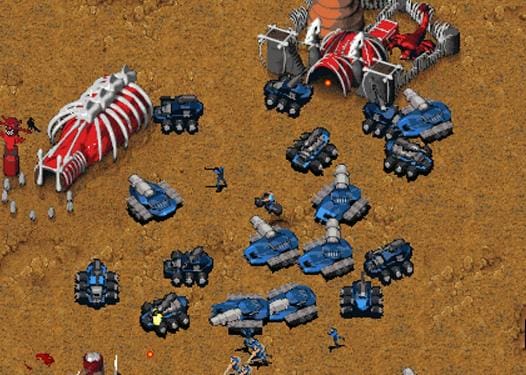KKND, short for “Krush, Kill ‘n’ Destroy,” is a real-time strategy (RTS) game series developed by Australian studio Beam Software (later renamed to Krome Studios Melbourne). The franchise includes two main games: KKND: Krush Kill ‘n’ Destroy (1997) and KKND2: Krossfire (1998), along with an expansion pack called KKND: Xtreme (1997).
In KKND, players control one of three factions in a post-apocalyptic world where humans have divided into different factions after a nuclear war. The factions include the Survivors (remnants of humanity), the Evolved (mutated creatures), and the Series 9 (sentient robots). Each faction has its own units, technologies, and playstyle.
KKND Facts
- KKND, short for “Krush Kill ‘n’ Destroy,” is a real-time strategy (RTS) game series developed by Beam Software (later renamed to Krome Studios Melbourne).
- The franchise includes two main games: KKND: Krush Kill ‘n’ Destroy (1997) and KKND2: Krossfire (1998).
- KKND takes place in a post-apocalyptic world where humans have divided into different factions after a nuclear war.
- The three playable factions in KKND are the Survivors (remnants of humanity), the Evolved (mutated creatures), and the Series 9 (sentient robots).
- Each faction has its own distinct units, buildings, technologies, and playstyle, providing strategic variety.
- The game offers both single-player campaigns with missions and a skirmish mode for multiplayer battles against AI or other players.
- KKND features a diverse range of units, including infantry, vehicles, aircraft, and specialized units with unique abilities.
- Resource management is a key aspect of gameplay, with players needing to gather resources like oil and scrap metal to fund construction, research, and unit production.
- The technology tree allows players to research new technologies to unlock advanced units, upgrades, and defensive structures.
- The game provides a variety of map environments, including deserts, forests, and ruined cities, each with its own strategic advantages and challenges.
- KKND offers a range of weather effects, such as sandstorms and acid rain, which can impact unit visibility and movement.
- The game features cinematic cutscenes to advance the storyline and provide context for the missions.
- KKND: Xtreme is an expansion pack for the original game, which introduced additional missions, units, and multiplayer maps.
- Each faction in KKND has unique strengths and weaknesses, encouraging different tactical approaches and strategies.
- KKND supports multiplayer gameplay, allowing players to compete against each other over local area networks (LAN) or online.
- The game’s art style features a dark and gritty post-apocalyptic atmosphere, with distinct visual designs for each faction.
- Base building is an essential aspect of gameplay, with players constructing structures to produce units, research technologies, and defend their bases.
- Defensive structures and fortifications can be built to protect bases from enemy attacks.
- KKND includes voice acting for unit responses and mission briefings, adding to the immersion of the gameplay experience.
- The games feature original soundtracks that complement the gameplay and enhance the atmosphere of the post-apocalyptic world.
- KKND received positive reviews from critics and achieved commercial success, becoming a notable RTS franchise of the late 1990s.
- The games have a dedicated modding community that has created custom maps, campaigns, and modifications to extend the gameplay experience.
- KKND: Krush Kill ‘n’ Destroy was one of the first RTS games to incorporate three-dimensional terrain and slopes in its gameplay.
- The KKND series provided an alternative take on the RTS genre, offering unique factions and a post-apocalyptic setting.
- KKND remains a nostalgic favorite for fans of classic real-time strategy games, with its distinct factions, strategic gameplay, and memorable atmosphere.
Here are some tips and gameplay suggestions for KKND (Krush Kill ‘n’ Destroy):
- Master Resource Management: Efficiently manage your resources, such as oil and scrap metal, to ensure a steady income. Expand your resource-gathering operations early on to support your base construction and unit production.
- Establish Strong Defenses: Build defensive structures, such as gun turrets and missile silos, to protect your base from enemy attacks. Place them strategically to cover key entry points and vulnerable areas.
- Scout and Gather Intelligence: Utilize scout units to explore the map and reveal enemy positions. Gather information about their base layout, unit compositions, and defensive structures to plan your strategies accordingly.
- Balance Your Unit Composition: Create balanced armies by including a mix of different unit types. Have infantry for capturing enemy structures, vehicles for mobility and firepower, and air units for reconnaissance and hit-and-run tactics.
- Prioritize Research: Invest in researching technologies that enhance your units, unlock new units or structures, and improve your base’s defensive capabilities. Focus on upgrades that align with your chosen faction’s strengths and playstyle.
- Exploit Terrain: Take advantage of the terrain features to gain tactical advantages. Use forests and hills for cover, place defensive structures on high ground, and position your units strategically to maximize their effectiveness.
- Target Priority: Set your units’ target priorities appropriately. Focus fire on high-value targets, such as enemy structures or powerful units, to eliminate threats quickly and weaken the enemy’s defenses.
- Keep Your Units Active: Continuously use your units to scout, capture resources, harass the enemy, or defend your base. Keeping your units active and engaged will make them more valuable and prevent them from becoming idle.
- Coordinate Attacks: Plan coordinated attacks by timing your assaults with allies in multiplayer or coordinating between different groups of units in single-player. Attacking from multiple angles can overwhelm the enemy and divide their defenses.
- Utilize Special Abilities: Take advantage of special abilities unique to your faction’s units. These abilities can provide powerful advantages in combat, such as healing, stealth, or area-of-effect damage. Use them strategically to turn the tide of battles.
- Monitor Enemy Production: Keep an eye on the enemy’s production capabilities. If you notice specific units being consistently produced, adjust your strategy and unit composition accordingly to counter their strengths.

